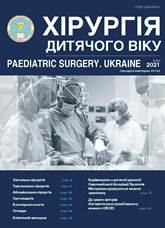Method of fixing titanium pectus bar in surgical correction of funnel chest and its mathematical modeling
DOI:
https://doi.org/10.15574/PS.2021.71.21Keywords:
Nuss procedure, funnel chest, fixing bardimensions, method of fixationAbstract
The most common surgery for the correction of congenital funnel chest in the 21st century is the Nuss procedure. This intervention is accompanied by complications related to the actual fixing bar and its size and placement and methods of fixing. The most common of these are bar displacement and chronic postoperative pain. Only one size of corrective bar (thickness, width) is used for this type of operation in all age groups.
Purpose – to develop and implement the original modification of the Nuss procedure with individual calculation of the minimum dimensions of the corrective bar; to eliminate the probability of bar displacement; reduce the duration and intensity of postoperative pain.
Materials and methods. The original method of the correcting titanium bar fixing as a monolithic metal arched structure with rigidly fixed ends was used in the study, the subperiostal fastening of the bar stabilizers to two ribs on each side was used. This method was used to operate on 34 patients with funnel chest aged from 6 to 17 years.
Results. Mathematical modeling of the functioning of the correcting bar as a monolithic metal arched structure with rigidly fixed ends and determination of its strength and rigidity were performed. As an example, when calculating the stiffness of a plate with a width of 12 mm and a thickness of 2.2 mm under the use of a load of 25 kg (250 N) and an arch width of 20 cm, we determine the deflection of the bar 3.57 mm, strength factor 1.8. The loads of 250 N are much higher than those that actually exist. The cases of depression of the thorax (deflection of the bar) and cases of eruption of the bar were non indicated. The analyzis the level of postoperative pain syndrome on the NRSP scale for 4–5 days after surgery in patients with II degree of funnel chest determined an average score of 3.74; with III degree – 4.18; after one month of the operation – 1.0 and 1.63, respectively. Chronic postoperative pain was not noted.
Conclusions. Rigid subptriostal fixation of the bat stabilizers to two ribs on each side prevents the plate from shifting. The proposed method of mathematical modeling of plate dimensions allows to individually calculate the dimensions of the correcting bar, providing in the vast majority of cases the correction of deformation bars 10, 11, 12 mm. The intensity and duration of the pain syndrome is much less than in standard technique due to the redistribution of pressure on the fulcrums of the bar and the absence of injury to the intercostal nerves, reducing the size of the plate.
The research was carried out in accordance with the principles of the Helsinki declaration. The study protocol was approved by the Zhytomyr Regional Pediatric Clinical Hospital of the Zhytomyr Regional Council, Ukraine. The informed consent of the patient was obtained for conducting the studies.
No conflict of interest was declared by the authors.
References
Feodosev VI. (1986). Soprotivlenie materialov. Uchebnik dlya VTUZov. Moskva: Nauka: 512.
Jose Ribas Milanez de Campos, Miguel Lia Tedde. (2016). Management of deep pectus excavatum (DPE) Ann Cardiothorac Surg. 5 (5): 476-484. https://doi.org/10.21037/acs.2016.09.02; PMid:27747181 PMCid:PMC5056944
Kubiak R, Habelt S, Hammer J, Hacker FM, Mayr J, Bielek J. (2007). Pulmonary function following completion of Minimally Invasive Repair for Pectus Excavatum (MIRPE). Eur J Pediatr Surg. 17: 255-260. https://doi.org/10.1055/s-2007-965060; PMid:17806022
Nuss D, Kelly RE. (2014). The minimally invasive repair of pectus excavatum. Oper Tech Thorac Cardiovasc Surg. 19 (3): 324-347. https://doi.org/10.1053/j.optechstcvs.2014.10.003
Piskunov VH. (1999). Opir materialiv z osnovamy teorii pruzhnosti y plastychnosti. Za red. VH Piskunova. Kn. 1–3. Kyiv: «Vyshcha shkola»: 204.
Downloads
Published
Issue
Section
License
The policy of the Journal “PAEDIATRIC SURGERY. UKRAINE” is compatible with the vast majority of funders' of open access and self-archiving policies. The journal provides immediate open access route being convinced that everyone – not only scientists - can benefit from research results, and publishes articles exclusively under open access distribution, with a Creative Commons Attribution-Noncommercial 4.0 international license(СС BY-NC).
Authors transfer the copyright to the Journal “PAEDIATRIC SURGERY.UKRAINE” when the manuscript is accepted for publication. Authors declare that this manuscript has not been published nor is under simultaneous consideration for publication elsewhere. After publication, the articles become freely available on-line to the public.
Readers have the right to use, distribute, and reproduce articles in any medium, provided the articles and the journal are properly cited.
The use of published materials for commercial purposes is strongly prohibited.

